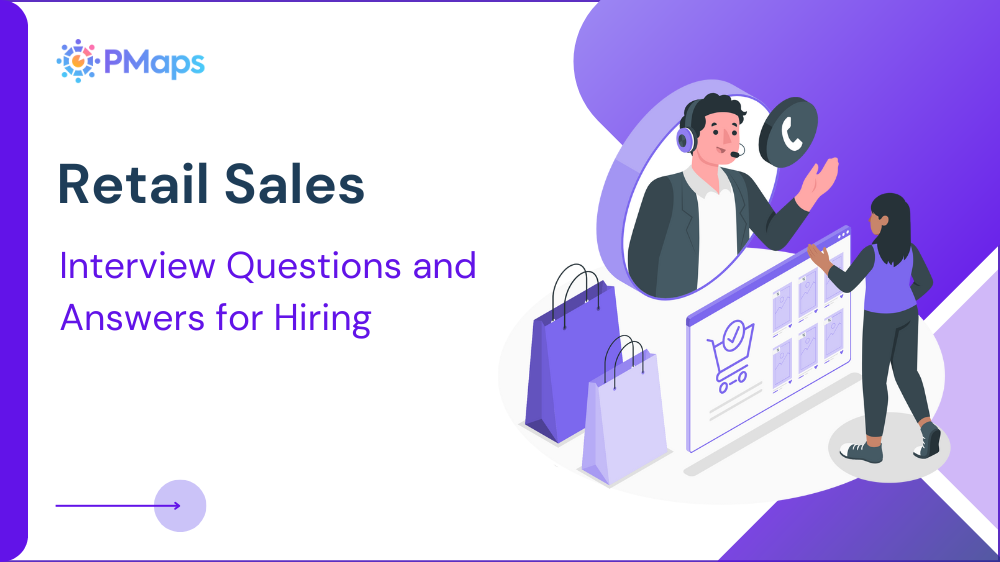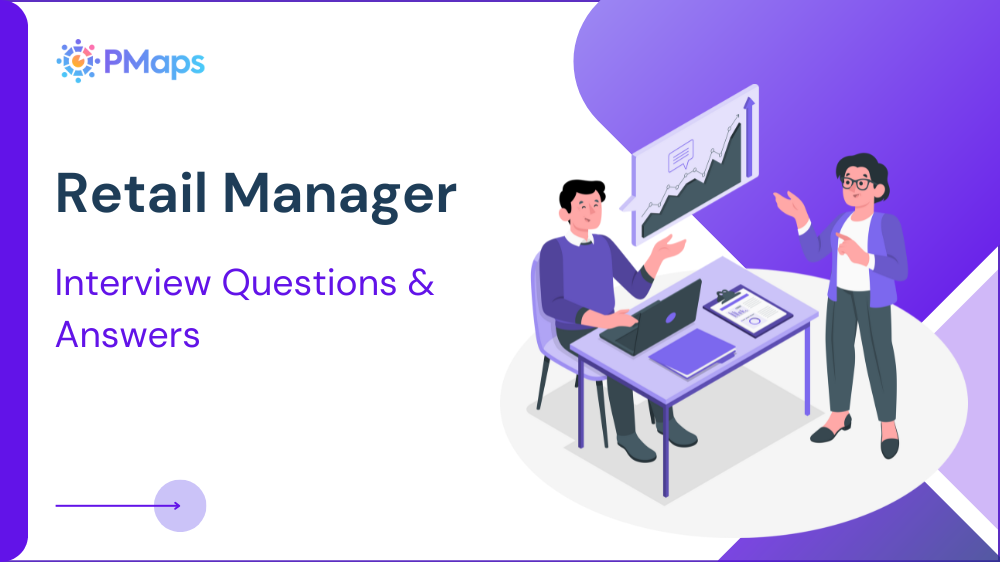
Retail sales interview questions help you screen for poise, persuasion, and reliability. Great hires read customers, handle objections, and protect margins without harming experience. This guide follows a clear format for busy hiring teams. Use it to compare candidates fairly and hire sellers who lift revenue and retention.
General Interview Questions for Retail Sales
Start with broad prompts that uncover motivation, product curiosity, and customer communication basics before drilling into quotas or KPIs. These questions establish a baseline for attitude and store-readiness. Strong answers show structure, credible examples, and calm in footfall surges. Use these to filter early and focus panel time wisely.
1) What does great customer service look like on a busy day?
What it assesses
Service mindset and prioritization.
What to look for
Greeting discipline, triage, and clear handoffs. Watch for empathy and queue management.
Sample answer
“I greet quickly, set expectations, and triage needs. I handle quick wins first, then stay with complex cases. I loop in a teammate if needed and update waiting customers politely. Customers feel seen, not ignored.”
2) How do you learn a new product line quickly?
What it assesses
Product learning habits.
What to look for
Feature-to-benefit mapping, demo practice, and objection notes.
Sample answer
“I break features into customer benefits, build quick comparison cards, and practice two-minute demos. I log common questions and refine talking points each shift. I also shadow top sellers for phrasing that lands.”
3) Describe your approach to add-on and cross-sell without feeling pushy.
What it assesses
Value framing and timing.
What to look for
Needs-based suggestions, consent language, and simple bundles.
Sample answer
“I only suggest items that improve the main purchase. I ask permission and explain the benefit in one sentence. If interest is low, I move on gracefully and protect the experience.”
4) How do you handle price objections at the counter?
What it assesses
Objection handling and confidence.
What to look for
Benefit recap, alternative options, and loyalty hooks.
Sample answer
“I restate the need, link the benefit, and offer a suitable alternative if budget is tight. I highlight warranty or loyalty savings. If it’s still a no, I close warmly for future visits.”
5) What metrics matter most to you in retail sales?
What it assesses
Commercial awareness.
What to look for
Conversion, average transaction value, units per transaction, and shrink awareness.
Sample answer
“I track conversion, transaction value, and units per transaction daily. I also care about returns and shrink, because both affect profit. I plan my shifts to lift at least one metric each day.”
Behavioral Interview Questions
Behavioral prompts reveal habits built over many shifts. Retail brings peak hours, stock issues, and tough conversations. You want calm, ownership, and clear teamwork signals. Ask for STAR answers and push for specifics. Strong candidates show measured outcomes and repeatable routines, not luck or scripts.
6) Tell me about a time you turned a near-walkout into a sale.
What it assesses
Recovery skill and persuasion.
What to look for
Active listening, targeted benefits, and respectful close.
Sample answer
“A customer disliked the fit and price. I offered a tailored cut, showed a quick mirror demo, and explained care savings. They bought the alternative and a care kit. Receipt notes show reduced returns later.”
7) Describe a time you helped a teammate hit their target.
What it assesses
Team ethos and coaching.
What to look for
Knowledge sharing and clean handoffs.
Sample answer
“A new hire froze on a stroller demo. I modeled a three-step demo, then watched them try again. They closed and gained confidence. We repeated the drill across other items that week.”
8) Share a moment you handled a difficult customer complaint.
What it assesses
De-escalation and ownership.
What to look for
Apology, remedy options, and policy awareness.
Sample answer
“A customer was upset about a delayed pickup. I apologized, checked status, and offered an immediate substitute or courier delivery. They chose delivery and thanked us for the quick fix.”
9) Tell me about a time you improved a slow category.
What it assesses
Merchandising eye and initiative.
What to look for
Simple tests, signage tweaks, and data follow-up.
Sample answer
“Phone cases lagged. I moved bestsellers to eye level and added a two-line benefit tag. Units per day doubled over the next week, with no markdowns.”
10) Describe a time you handled return abuse or policy pressure.
What it assesses
Policy control and tact.
What to look for
Calm language, clear policy, and manager escalation when needed.
Sample answer
“I explained the policy, offered store credit within rules, and stayed polite. I involved my supervisor calmly when the customer insisted. We protected policy and ended respectfully.”
Situational Interview Questions
Scenarios test judgment in common floor challenges. Stockouts, queues, and promos collide daily. Good hires show structure, not panic. Look for clear steps, customer updates, and teamwork. The aim is predictable service under pressure while safeguarding revenue and brand trust.
11) The item a customer wants is out of stock. What now?
What it assesses
Problem solving and save-the-sale behavior.
What to look for
Alternatives, ship-to-home, and waitlist options.
Sample answer
“I confirm need, check nearby stores, and offer free ship-to-home if eligible. I present one similar option and explain differences clearly. I invite them to a restock alert and thank them for the patience.”
12) You spot a long queue forming. How do you react?
What it assesses
Queue control and communication.
What to look for
Speed signals, line updates, and smart delegation.
Sample answer
“I call for backup, open a new till if trained, and pre-bag simple items. I update waiting customers with honest timing and keep the line moving with card-ready prompts.”
13) A promo changes midday and confuses customers. Your move?
What it assesses
Clarity and compliance.
What to look for
Signage check, quick script, and manager sync.
Sample answer
“I confirm the new terms, update signs, and use a one-line script at greeting. I brief teammates in two minutes. Confusion drops and complaints taper off quickly.”
14) A colleague mishandles a customer in front of you. What do you do?
What it assesses
Professional rescue and respect.
What to look for
Supportive handoff and private coaching.
Sample answer
“I step in politely, thank my colleague, and take over with a helpful tone. After the customer leaves, I share a quick tip privately and offer to role-play.”
15) You must sell a higher-margin alternative ethically. How?
What it assesses
Integrity and value framing.
What to look for
Needs match and transparent benefits.
Sample answer
“I confirm needs, show the alternative, and explain the durable benefit. If it fits poorly, I drop it. The customer’s trust beats a one-time upsell.”
Technical or Role-Specific Questions
Retail success relies on simple, reliable routines. These prompts check POS fluency, inventory basics, visual standards, and loss prevention awareness. Strong answers show repeatable steps, tidy records, and respect for cash and compliance. Look for clear, short methods that scale across shifts.
16) How do you prevent shrink while staying customer friendly?
What it assesses
Loss awareness and floor behavior.
What to look for
Greeting, tidy zones, and discreet checks.
Sample answer
“I greet every entry, keep zones neat, and watch for tag tampering. I never accuse. I follow escalation steps and log incidents accurately.”
17) Walk me through a clean POS transaction during peak hours.
What it assesses
Till speed and accuracy.
What to look for
Item scan flow, loyalty capture, and receipt choice.
Sample answer
“I confirm items, scan fast, and ask about loyalty. I verify total, take payment, and offer digital receipts. I thank customers by name when possible.”
18) How do you keep displays compliant during promotions?
What it assesses
Visual standards and discipline.
What to look for
Planogram use and quick fixes.
Sample answer
“I follow the planogram, check facings each hour, and replace gaps quickly. I escalate missing stock and keep signage exact. Photos go to the manager for record.”
19) What is your method to raise average transaction value?
What it assesses
Basket building.
What to look for
Relevant bundles and timing.
Sample answer
“I prepare two bundle ideas per shift based on current promos. I offer one helpful add-on after confirming the main need. I stop if interest is low.”
20) How do you capture and use customer feedback in-store?
What it assesses
Listening and improvement loop.
What to look for
Simple prompts and note capture.
Sample answer
“I ask one short question at checkout, note themes, and share during huddles. If an issue repeats, I test a small fix next shift.”
Pro Tips for Interviewing Retail Sales Candidates
Retail hiring benefits from short, practical tests. Simulate the floor to see real behavior. Score for clarity, warmth, and close technique. Keep tasks brief and relevant. Pair interviews with a standardized retail sales test to reduce guesswork and bias across stores.
- Run a three-minute product demo with a price objection.
- Ask for two ethical add-on suggestions tied to benefits.
- Time a mock checkout, including loyalty capture and receipt options.
- Role-play a return within policy limits.
- Review a quick planogram fix with before/after photos.
Conclusion
Great retail hires sell with respect and consistency. Use these questions to test service habits, recovery skill, and commercial focus. Define expectations using a tailored retail sales job description and standardize screening with our [retail sales test]. For support, call 8591320212 or email assessment@pmaps.in.








